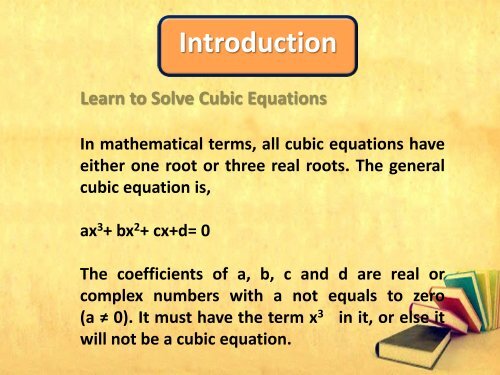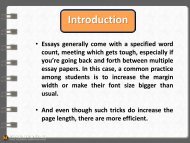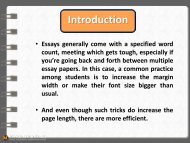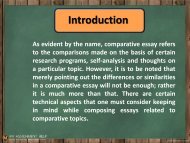How to Solve Cubic Equation pdf
Create successful ePaper yourself
Turn your PDF publications into a flip-book with our unique Google optimized e-Paper software.
Introduction<br />
Learn <strong>to</strong> <strong>Solve</strong> <strong>Cubic</strong> <strong>Equation</strong>s<br />
In mathematical terms, all cubic equations have<br />
either one root or three real roots. The general<br />
cubic equation is,<br />
ax 3 + bx 2 + cx+d= 0<br />
The coefficients of a, b, c and d are real or<br />
complex numbers with a not equals <strong>to</strong> zero<br />
(a ≠ 0). It must have the term x 3 in it, or else it<br />
will not be a cubic equation.
Introduction<br />
The coefficients of a, b, c and d are real or<br />
complex numbers with a not equals <strong>to</strong> zero<br />
(a ≠ 0). It must have the term x 3 in it, or else it<br />
will not be a cubic equation. But any or all of b, c<br />
and d can be zero.<br />
The examples of cubic equations are,<br />
No 1, x 3 + 3a 3 + 3 a 2 + a 3 – b=0<br />
No 2, 4x 3 + 57=0<br />
No 3, x 3 + 9x=0
Strategy <strong>to</strong> <strong>Solve</strong> <strong>Cubic</strong><br />
<strong>Equation</strong><br />
Unlike quadratic equation which may have no<br />
real solution; a cubic equation always has at<br />
least one real root. The prior strategy of solving<br />
a cubic equation is <strong>to</strong> reduce it <strong>to</strong> a quadratic<br />
equation, and then solve the quadratic by usual<br />
means, either by fac<strong>to</strong>rizing or using a formula.<br />
Always try <strong>to</strong> find the solution of cubic<br />
equations with the help of the general equation,<br />
ax 3 + bx 2 + cx+d= 0
Strategy <strong>to</strong> <strong>Solve</strong> <strong>Cubic</strong><br />
<strong>Equation</strong><br />
A cubic equation should, therefore, must be rearranged<br />
in<strong>to</strong> its standard form,<br />
For example,<br />
x 2 + 4x-1 = 6/x
Strategy <strong>to</strong> <strong>Solve</strong> <strong>Cubic</strong><br />
<strong>Equation</strong><br />
Step 1<br />
You can see the equation is not written in<br />
standard form, you need <strong>to</strong> multiply the ‘x’ <strong>to</strong><br />
eliminate the fraction and get cubic equation,<br />
after doing so, you will end up with<br />
x 3 + 4x 2 – x = 6
Strategy <strong>to</strong> <strong>Solve</strong> <strong>Cubic</strong><br />
<strong>Equation</strong><br />
Step 2<br />
Then you subtract 6 from both sides in order <strong>to</strong><br />
get ‘0’ on the right side, so you will come up,<br />
x 3 + 4x 2 – x- 6 = 0
Solving <strong>Cubic</strong> <strong>Equation</strong>s with<br />
the help of Fac<strong>to</strong>r Theorem<br />
What is fac<strong>to</strong>r theorem? If you divide a<br />
polynomial p(x) by a fac<strong>to</strong>r x – a of that<br />
polynomial, then, you will end up with zero as<br />
the remainder,<br />
p(x) = (x – a)q(x) + r(x)
Solving <strong>Cubic</strong> <strong>Equation</strong>s with<br />
the help of Fac<strong>to</strong>r Theorem<br />
If x – a is indeed a fac<strong>to</strong>r of p(x), then the<br />
remainder after division by x – a will be zero.<br />
Here is a problem,<br />
With x= – 2 a solution.<br />
p(x) = (x – a)q (x)<br />
x 3 – 5x 2 – 2x+24 = 0
Solving <strong>Cubic</strong> <strong>Equation</strong>s with<br />
the help of Fac<strong>to</strong>r Theorem<br />
If x – a is indeed a fac<strong>to</strong>r of p(x), then the<br />
remainder after division by x – a will be zero.<br />
Here is a problem,<br />
With x= – 2 a solution.<br />
p(x) = (x – a)q (x)<br />
x 3 – 5x 2 – 2x+24 = 0
Solving <strong>Cubic</strong> <strong>Equation</strong>s with<br />
the help of Fac<strong>to</strong>r Theorem<br />
Fac<strong>to</strong>r theorem says that if x = – 2 is a solution<br />
of this equation, then x+2 is a fac<strong>to</strong>r of this<br />
whole expression.
Solving <strong>Cubic</strong> <strong>Equation</strong>s with<br />
Step 1<br />
the help of Fac<strong>to</strong>r Theorem<br />
First, you need <strong>to</strong> look at the coefficients of the<br />
original cubic equation, which are 1, -5, -<br />
2 and 24.
Solving <strong>Cubic</strong> <strong>Equation</strong>s with<br />
the help of Fac<strong>to</strong>r Theorem<br />
Step 2<br />
Now multiply number (1) that just brought<br />
down, by the known root -2, as a result is -2, you<br />
mention the result in the other line, like
Solving <strong>Cubic</strong> <strong>Equation</strong>s with<br />
the help of Fac<strong>to</strong>r Theorem<br />
Step 3<br />
The numbers in the second column are added,<br />
so giving us,
Solving <strong>Cubic</strong> <strong>Equation</strong>s with<br />
the help of Fac<strong>to</strong>r Theorem<br />
Step 4<br />
Then recently written number 7 is multiplied by<br />
the known root, – 2,<br />
As 14 comes as a result, you need <strong>to</strong> write it<br />
down on the second row over the line,
Solving <strong>Cubic</strong> <strong>Equation</strong>s with<br />
the help of Fac<strong>to</strong>r Theorem<br />
Step 5<br />
Like previously the numbers in this column<br />
added, (14 – 2 = 12)
Solving <strong>Cubic</strong> <strong>Equation</strong>s with<br />
the help of Fac<strong>to</strong>r Theorem<br />
Step 6<br />
And you need <strong>to</strong> go on with the process,
Solving <strong>Cubic</strong> <strong>Equation</strong>s with<br />
Step 7<br />
the help of Fac<strong>to</strong>r Theorem<br />
When you have zero at the bot<strong>to</strong>m row, it gives<br />
the confirmation that x = – 2 is a root of the<br />
original cubic. At this stage, you got the first<br />
three numbers in the bot<strong>to</strong>m row as the<br />
coefficients in the quadratic,<br />
x 2 – 7x+12<br />
Hence, you reduced your cubic <strong>to</strong>,
Solving <strong>Cubic</strong> <strong>Equation</strong>s with<br />
the help of Fac<strong>to</strong>r Theorem<br />
(x+2)(x 2 – 7x + 12) =0<br />
Step 8<br />
After applying the quadratic term, the equation<br />
comes like this,<br />
(x +2) (x – 3) (x – 4) = 0<br />
Resulting, you get the solution as x = -2 or 3 or 4.
Solving <strong>Cubic</strong> <strong>Equation</strong>s with<br />
the help of Fac<strong>to</strong>r Theorem<br />
Another Example:<br />
The equation is,<br />
x 3 – 7x-6=0<br />
Step 1 You can simply try x = – 1, after putting<br />
the value of x, you will get,<br />
(-1) 3 – 7(-1) -6
Solving <strong>Cubic</strong> <strong>Equation</strong>s with<br />
Step 2<br />
the help of Fac<strong>to</strong>r Theorem<br />
After applying the synthetic division, like above<br />
example, you will take the coefficients of the<br />
original cubic equation, which are 1, 0, -7 and -6,<br />
you need <strong>to</strong> write down the know root x = -1 <strong>to</strong><br />
the right of the vertical line, giving us,
Solving <strong>Cubic</strong> <strong>Equation</strong>s with<br />
Step 3<br />
the help of Fac<strong>to</strong>r Theorem<br />
Multiply the brought down number 1 by the<br />
known root x = -1, and put down the result (-<br />
1) at the second row, like this,
Solving <strong>Cubic</strong> <strong>Equation</strong>s with<br />
Step 4<br />
the help of Fac<strong>to</strong>r Theorem<br />
The numbers of the second column are added <strong>to</strong><br />
the first column, giving us,
Solving <strong>Cubic</strong> <strong>Equation</strong>s with<br />
Step 5<br />
the help of Fac<strong>to</strong>r Theorem<br />
As you add more numbers <strong>to</strong> the second column<br />
by following the synthetic division process, you<br />
will come with,
Solving <strong>Cubic</strong> <strong>Equation</strong>s with<br />
Step 6<br />
the help of Fac<strong>to</strong>r Theorem<br />
Hence, the cubic reduced <strong>to</strong> quadratic,<br />
(x+1)(x 2 -x- 6) =0<br />
The fac<strong>to</strong>rized result is,<br />
(x +1)(x – 3)(x + 2) = 0<br />
You can get three solutions <strong>to</strong> the cubic<br />
equation are x = -2, -1 or 3
Are you looking for Assignment<br />
Help with 100% accuracy,<br />
My assignment help .com have<br />
3000+ Professional Writers are<br />
here <strong>to</strong> help with your<br />
Assignment Writing & also<br />
provide 24×7 Online Support.
<strong>How</strong> MyAssignmenthelp.com can help students<br />
in maths assignment?<br />
MyAssignmenthelp.com has carefully evaluated and<br />
assembled a highly-skilled team of in-house experts<br />
who are capable of giving the finest maths homework<br />
help you deserve. Your paper will be written by<br />
experienced writers in a professional<br />
manner. Assignment experts make sure that there are<br />
no traces of plagiarism in your content, they only deliver<br />
genuine work within the given time limit. If you think<br />
sample assignments can help you in your assignment,<br />
MyAssignmenthelp.com offers free samples. Our<br />
cus<strong>to</strong>mer support agents can guide you on how <strong>to</strong> get<br />
free assignments quotes and place your orders.
Contact Us<br />
Australia<br />
+61-3-4000-0033<br />
United Kingdom<br />
+44-121-285-4112<br />
Dubai<br />
+971-8000320360<br />
Mail Id<br />
contact@myassignmenthelp.com

















